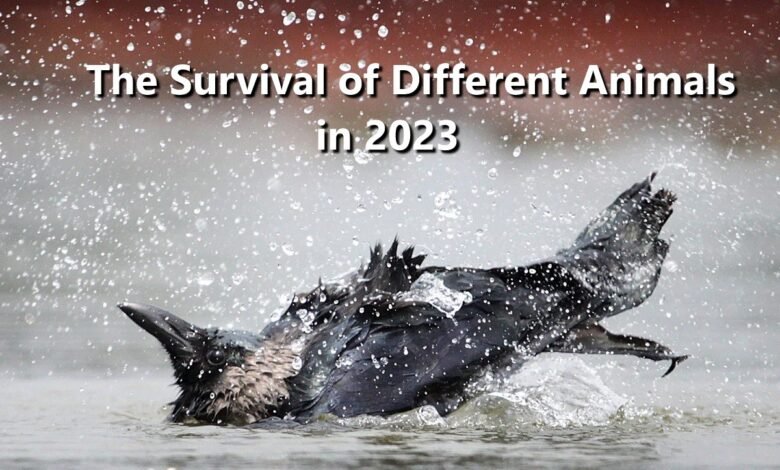The Survival Instincts of Different Animals in 2023

As we enter the year 2023, the world has witnessed a rapid change in the environment. Climate change, natural disasters, and human intervention have significantly impacted the lives of different species. However, different animals adapt to changing environments and have a remarkable ability to adapt to their surroundings and develop survival instincts to overcome the challenges that come their way. In this article, YezzBuzz will explore how different animals are evolving to survive in 2023 and the Survival Instincts of Different Animals in 2023 means that what strategies they use to thrive in the changing world.
Adaptations of Animals
Changes in Migration Patterns
Animals are adapting to the changing environment by altering their migration patterns. Many species, such as birds and fish, rely on seasonal movements to find food and mates. However, with the increasing temperatures and changing weather patterns, animals are adjusting their migration timings and routes to find more favorable conditions. For example, some birds are migrating earlier than usual to take advantage of the longer growing season, while others are moving to higher altitudes to escape the heat.
Evolution of Body Structures
Another way animals are adapting is through the evolution of their body structures. Species that live in extreme environments, such as the Arctic or the Sahara desert, have developed unique physical features to help them survive. For example, the Arctic fox has a thick coat of fur and small ears to conserve heat, while the kangaroo rat has large ears to dissipate heat and avoid dehydration.
Changes in Feeding Habits
Animals are also changing their feeding habits to cope with the changes in their environment. Many species are shifting to new food sources as their traditional sources become scarce. For example, some Arctic birds are switching from a diet of fish to one of the insects as the melting sea ice makes it harder to find fish. Similarly, some herbivores are moving to new areas to find suitable grazing land, while others are developing more efficient digestive systems to extract nutrients from tough plants.
Evolution of Body Structures
Another way animals are adapting is through the evolution of their body structures. Species that live in extreme environments, such as the Arctic or the Sahara desert, have developed unique physical features to help them survive. For example, the Arctic fox has a thick coat of fur and small ears to conserve heat, while the kangaroo rat has large ears to dissipate heat and avoid dehydration.
Changes in Feeding Habits
Animals are also changing their feeding habits to cope with the changes in their environment. Many species are shifting to new food sources as their traditional sources become scarce. For example, some Arctic birds are switching from a diet of fish to one of insects as the melting sea ice makes it harder to find fish. Similarly, some herbivores are moving to new areas to find suitable grazing land, while others are developing more efficient digestive systems to extract nutrients from tough plants.
Read More: 10 Tips for Keeping Your Pet Safe and Happy
Survival Instincts of Different Animals in 2023
Polar Bears
Polar bears are one of the most iconic species affected by climate change. As the Arctic sea ice melts, they are losing their primary hunting grounds and are forced to swim longer distances in search of food. However, polar bears have a remarkable sense of smell and can detect prey from a mile away. They also have a layer of blubber that helps them stay warm in the freezing waters. In 2023, polar bears are expected to continue to adapt by changing their hunting techniques and relying on alternative food sources such as seal carcasses.
Elephants
Elephants are known for their intelligence and social nature, which have helped them survive in the wild. In 2023, elephants are facing a significant threat from poaching and habitat loss. However, they have developed several survival instincts to protect themselves and their young. For example, when faced with danger, elephants will form a defensive circle around the young and trumpet loudly to scare off predators. They also have a keen sense of hearing and can detect low-frequency sounds that are inaudible to humans, allowing them to communicate with each other over long distances.
Chameleons
Chameleons are known for their remarkable ability to change color to blend into their surroundings. They achieve this by manipulating the pigments in their skin cells, which allows them to display a wide range of colors and patterns. This camouflage technique helps them to hide from predators and to stalk prey more effectively.
Eye Movement
Another unique feature of chameleons is their ability to move their eyes independently. Each eye can pivot and focus on a different object, giving them a 360-degree view of their surroundings. This allows them to scan for predators and prey without having to move their entire body, which could give away their position.
Prehensile Tail
Chameleons also have a prehensile tail, which means they can grasp and hold onto objects. This tail helps them to maintain balance and grip branches as they move through the trees. It also provides them with an extra appendage to help them catch prey or defend themselves against predators.
Adaptation to Environments
Different species of chameleons have adapted to different environments. For example, some species live in trees while others live on the ground. Some have adapted to arid climates while others live in more humid environments. These adaptations have led to differences in their physical features, such as the size and shape of their feet and the color of their skin.
Impact of The Survival Instincts of Different Animals in 2023

Loss of Biodiversity
As animals adapt to the changing environment, some species may not be able to keep up with the pace of change. This can lead to a loss of biodiversity, as certain species may go extinct or become endangered. This can have a ripple effect throughout the ecosystem, as other species may rely on the affected species for food or habitat.
Spread of Diseases
The changing environment can also impact the spread of diseases. As animals move into new habitats and interact with other species, they may be exposed to new pathogens and parasites. This can lead to the spread of diseases that were previously isolated to certain regions or populations. This can have implications for both animal and human health, as some diseases can be zoonotic and can be transmitted from animals to humans.
Impact on Agriculture
The survival instincts of different animals can also impact agriculture. As animals adapt to changing conditions, they may move into areas where crops are grown, leading to crop damage and loss. This can have economic implications for farmers and food security implications for populations that rely on these crops for sustenance.
Changes in Ecosystem Dynamics
Changes in the survival instincts of different animals can also impact ecosystem dynamics. As certain species become more dominant or go extinct, this can have implications for the food web and other ecological interactions. This can lead to shifts in nutrient cycling, pollination, and other ecosystem services that are vital to human well-being.
Positive Outcomes
However, it’s important to note that the survival instincts of different animals can also have positive outcomes. For example, some species may adapt to new conditions and fill ecological niches that were previously vacant, leading to new opportunities for biodiversity and ecosystem functioning. Additionally, the adaptation of certain species may provide new insights into the mechanisms of evolution and the potential for organisms to adapt to changing environments.
FAQs
Q: What factors are contributing to changes in animal survival instincts? A: Changes in climate, habitat loss, pollution, and human activities such as hunting and development are all contributing factors to changes in animal survival instincts.
Q: Are all animals able to adapt to changing environments? A: No, not all animals are able to adapt to changing environments at the same pace or in the same way. Some species are more adaptable than others, and some may not be able to keep up with the rapid pace of environmental change.
Q: How can we help animals adapt to changing environments? A: We can help animals adapt to changing environments by reducing our impact on the environment through sustainable practices, protecting habitats, and supporting conservation efforts.
Q: What can we learn from the survival instincts of different animals? A: The survival instincts of different animals can provide insights into the mechanisms of evolution and the potential for organisms to adapt to changing environments. By studying these adaptations, we can gain a better understanding of how to manage and conserve ecosystems in the face of environmental change.
Conclusion
The survival instincts of different animals in 2023 are being tested by a changing environment. Climate change, habitat loss, pollution, and human activities are all contributing to changes in the way that animals adapt to their surroundings. Some species may be able to adapt quickly, while others may not be able to keep up with the pace of change. These changes can have negative impacts on biodiversity, human health, agriculture, and ecosystem dynamics. However, by studying the survival instincts of different animals, we can gain a better understanding of how to manage and conserve ecosystems in the face of environmental change. It is important to take action now to reduce our impact on the environment and support conservation efforts to help protect the survival instincts of different animals in the years to come.












One Comment